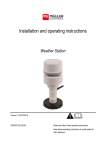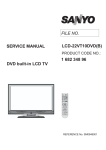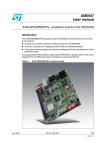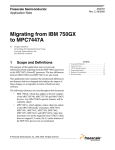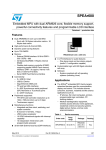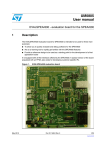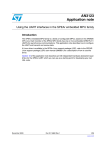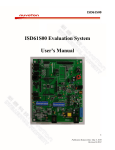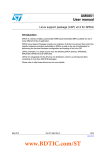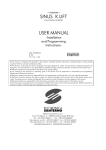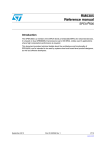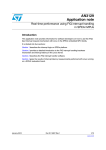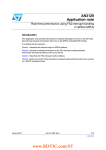Download PDF document - STMicroelectronics
Transcript
AN3132 Application note Configuring the SPEAr600 multi-port memory controller (MPMC) for external DDR SDRAM Introduction The SPEAr600 embedded MPU features a multi-port memory controller for interfacing with external DDR or DDR2 memory devices. This application note describes how to configure the MPMC to use different types of DDR and DDR2 memories and tune the parameters in accordance with JEDEC requirements and the flexibility available in the application. January 2010 Doc ID 16955 Rev 1 1/24 www.st.com Contents AN3132 Contents 1 SPEAr600 memory controller overview . . . . . . . . . . . . . . . . . . . . . . . . . 3 2 DDR overview . . . . . . . . . . . . . . . . . . . . . . . . . . . . . . . . . . . . . . . . . . . . . . 5 2.1 2.2 DDR2 vs. DDR1 . . . . . . . . . . . . . . . . . . . . . . . . . . . . . . . . . . . . . . . . . . . . . 5 2.1.1 Package differences . . . . . . . . . . . . . . . . . . . . . . . . . . . . . . . . . . . . . . . 7 2.1.2 Power supply differences . . . . . . . . . . . . . . . . . . . . . . . . . . . . . . . . . . . 8 2.1.3 Other feature differences . . . . . . . . . . . . . . . . . . . . . . . . . . . . . . . . . . . . . 8 Addressing . . . . . . . . . . . . . . . . . . . . . . . . . . . . . . . . . . . . . . . . . . . . . . . . . 8 3 DDR programming in Spear600 . . . . . . . . . . . . . . . . . . . . . . . . . . . . . . . 10 4 Configuring SPEAr MPMC for a specific DDR memory part . . . . . . . . 11 5 DDR controller delay lines tuning . . . . . . . . . . . . . . . . . . . . . . . . . . . . . 13 5.1 Reading from DRAM . . . . . . . . . . . . . . . . . . . . . . . . . . . . . . . . . . . . . . . . 13 5.2 Writing to DRAM . . . . . . . . . . . . . . . . . . . . . . . . . . . . . . . . . . . . . . . . . . . 13 5.2.1 Example using these parameters . . . . . . . . . . . . . . . . . . . . . . . . . . . . . 14 6 PCB layout recommendations . . . . . . . . . . . . . . . . . . . . . . . . . . . . . . . . 16 7 Pad descriptions and configurations . . . . . . . . . . . . . . . . . . . . . . . . . . 17 7.1 SSTLPAD_CFG_CTR register configuration . . . . . . . . . . . . . . . . . . . . . . 20 Appendix A Acronyms . . . . . . . . . . . . . . . . . . . . . . . . . . . . . . . . . . . . . . . . . . . . . . 22 Revision history . . . . . . . . . . . . . . . . . . . . . . . . . . . . . . . . . . . . . . . . . . . . . . . . . . . . 23 2/24 Doc ID 16955 Rev 1 AN3132 SPEAr600 memory controller overview 1 SPEAr600 memory controller overview In the SPEAr600 embedded MPU, different memory controllers provide interfaces between the system elements/blocks and external memory. The MPMC multi-port memory controller is used for interfacing DDR (double data rate) synchronous dynamic RAM (SDRAM). It is also responsible for reliable read-write operations to the memory. In a powerful system like SPEAr600, there are several system elements which may need to communicate with external DDR memory at any time to increase system efficiency. This is possible because the memory provides data at very high speed and system elements need time to process that data, so this time can be utilized by other system elements to transfer data to/from the memory. For example, during the time that the CPU processes some data or instructions, another master interface (CPU or DMA) can read or write to the memory. This can be handled by the MPMC’s multi-port capablity. For maximum flexibility the MPMC has one AHB slave port to configure the memory controller registers and seven AHB slave ports for data. Figure 1: SPEAr600 architecture gives an overview of the SPEAr600, showing the connections between the SDRAM controller AHB data ports (M0,..,M6) and the various subsystems of the design. Figure 1. SPEAr600 architecture SPEArPLUS ARM subsystem CPU1 ARM926EJS 16 KI/16 KD coprocessor cache Tcm I/D I D Configurable cell array subsystem SRAM SRAM 32 KB 32 KB APB Int ctr Tmr GPIO ARM subsystem CPU2 ARM926EJS 16 KI/16 KD coprocessor cache Tcm I/D I D APB Tmr Int ctr GPIO Q P M0 O N M1 M M2 M3 Multilayer bus interconnection matrix MPMC DDR1-2 6 45 F 2 31 1 3 G 6 H Mtx Cell array (application configurable) Mtx L 1234 1235 123 4 5 123 CFG 125 D C B A Mtx UART SPI E SPI I2C SRAM 32 KB SRAM 32 KB Tmr Flash NAND GPIO SPI RAM (8 KB) WDG RTC GPIO Sys Ctr ADC IrDA Low-speed connect Misc DMA (8 channels) CLCD controller Eth. GMAC USB2.0 Device ROM (32 KB) USB2.0 Host Flash serial USB2.0 Host Application subsystem Basic subsystem Common subsystems M4 Tmr M5 JPEG (Codec) Tmr M6 UART Mtx Expi I/T mux R HS connect. In order to understand how the various IPs interact with the external memory through the multi-port memory controller, the table below shows the driving masters present in SPEAr600 and the corresponding memory controller AHB slave data port. Doc ID 16955 Rev 1 3/24 SPEAr600 memory controller overview Table 1. AN3132 Memory controller AHB data ports Memory controller AHB data port Note: Driving masters M0 CPU2 M1 CPU1 M2 RAS_L, EXPI N3 DMA master 1, RAS_H, EXPI M4 Ethernet GMAC, RAS_Z M5 USB subsystem M6 RAS_E, CLCD controller RAS_L, RAS_H , RAS_E and RAS_Z are specific ports that can be used in customized SPEAr MPUs to connect masters to the external DDR. This memory controller supports DDR1 and DDR2 devices following JEDEC standard up to the clock frequency of 333MHz (data rate of 667 MT/sec). As the memory controller supports DDR1 & DDR2 at different frequencies for almost all DDR part manufacturers, MPMC must be programmed with the right timing parameters required for the selected DDR memory part, selected DDR frequency, selected CAS latency etc. This memory controller supports DDR1 and DDR2 devices, compliant with JEDEC standards, up to a clock frequency of 333 MHz (data rate 667 MT/sec). As the memory controller supports DDR1 and DDR2 at different frequencies for almost all DDR part manufacturers, MPMC must be programmed with the right timing parameters required for the selected DDR memory part, DDR frequency, CAS latency etc. 4/24 Doc ID 16955 Rev 1 AN3132 DDR overview 2 DDR overview 2.1 DDR2 vs. DDR1 DDR1 and DDR2 memory modules are widely used in desktop PCs. Their full name is DDR (double data rate) SDRAM (synchronous DRAM), which is a variant of dynamic RAM. Dynamic RAM differs from static RAM because the former, constituted by both transistors and capacitors, requires constant refreshing to restore the values in the capacitors while the latter, constituted only by transistors, does not require refreshing, resulting in much higher performance. However, SRAMs are much more expensive than DRAMs. Going back to SDRAM, this type of memory utilizes a synchronous interface: this means that it waits for a clock pulse to transfer data, and thus it is synchronized with the system bus and the processor. SDRAM transfers one bit (per data line) of data per clock cycle. DDR SDRAM technology doubles the bandwidth of SDRAM under optimal conditions. In fact, SDRAM transfers data on every clock cycle (to be specific, on the rising edge of every clock cycle), while DDR transfers data on both the rising and the falling edge of a clock cycle. Therefore, two bits (per data line) are transferred on every clock cycle. In order to do this, two bits are accessed from the memory array (where data is actually stored) for each data line on every clock cycle, this process is called the “2-bit prefetch”. In this way, the interface’s clock speed remains constant, but the data bus effectively doubles in frequency. The figure below shows a simple DDR1 SDRAM architecture example. Figure 2. DDR1 SDRAM architecture In general, a DRAM (non synchronous) address is presented in two parts: a row and a column address. The row and the column are multiplexed on the same set of address pins (DDR_MEM_ADDR [14:0] with reference to SPEAr600 pins) to reduce package, size and cost. First, the row address is loaded, or strobed, into the row address latch via the row address strobe, or RAS, followed by the column address with the column address strobe, or CAS. The Read data propagate to the output after a specified access time. Write data are presented at the same time as the column address, because it is the column strobe that actually triggers the transaction, whether read or write. The SDRAM internal state logic operates on discrete commands that are presented to it. The signals RAS and CAS (DDR_MEM_RAS and DDR_MEM_CAS, SPEAr600 pins) are still present, but they function as part of other control signals to form commands rather than simple strobes. Most of the input signals to the state logic shown in Figure 2 combine to form the discrete commands listed in Table 2. Doc ID 16955 Rev 1 5/24 DDR overview AN3132 Table 2. Basic SDRAM command set Command CS RAS CAS WE Address AP/A10 Bank activate L L H H Bank, row A10 Read L H L H Bank, column L Read with autoprecharge L H L H Bank, column H Write L H L L Bank, column L Write with autoprecharge L H L L Bank, column H No operation L H H H X X Burst terminate L H H L X X Bank precharge L L H L X L Precharge all banks L L H L X H Mode register set L L L L Configuration Configuration Auto refresh L L L H X X Device deselect H X X X X X A clock enable, CLKE (DDR_MEM_CLKEN, SPEAr600 pin), must be high for normal operations. Interface control signals are sampled on the rising clock edge. As SDRAM devices are manufactured in multibyte data bus width, Data (DDR_MEM_DQ, SPEAr600 pins) is a 16-bit wide bus in SPEAr600, the data mask DM (DDR_MEM_DM [1:0], SPEAr600 pins) provides a convenient way to selectively mask individual bytes from being written or being driven during reads. Some common functions include activating a row for future access, performing a read, and precharging a row (deactivating a row, often in preparation for activating a new row). The first requirement, for example, to read an SDRAM is to activate the desired row, on the desired bank (DDR_MEM_BA [2:0], SPEAr600 pins). To do this, you must use an activate command by asserting RAS for one cycle while presenting the desired bank and row address. The next command issued to continue the transaction is a read. However the controller must wait a number of cycles that corresponds to the DRAM array’s row-activate to column-strobe delay time. To use the read command, you must assert CAS and present the desired bank select and column address, along with the auto precharge (AP) flag. A particular bank must be selected because the multibank SDRAM architecture enables reads from any bank. In the case of reads and writes, the assertion of AP (address line 10) tells the SDRAM to automatically precharge the activated row after the requested transaction completes. Precharging a row returns it to quiescent state and also clears the way for another row in the same bank to be activated next time. A single bank cannot have more than one row active at any given time. Once the controller issues the read command, it must wait a predetermined number of cycles before the data is returned by the SDRAM. This delay is known as CAS latency. The data interface contains the data strobe signal (DDR_MEM_DQS [1:0], SPEAr600 pins). It is a bidirectional clock that is used to synchronize the reads and writes on the data bus. 6/24 Doc ID 16955 Rev 1 AN3132 DDR overview Being a 2nd generation DDR, the most important improvement found in DDR2 memory is its transfer data rate or bandwidth. As in the case of DDR SDRAM vs. SDRAM, the bandwidth of DDR2 memory can double the bandwidth of DDR. DDR already operates on both the rising and the falling edge of the clock, so DDR2 can achieve twice the bandwidth by doubling the I/O buffer frequency. DDR2 utilizes a “4-bit prefetch” architecture: this means that 4 bits of data are moved from the memory array to the I/O buffer per data line for each core clock cycle. The core clock cycle refers to the cycle time of the memory array, and the frequency of the memory array is half of the I/O buffers and ¼ of the data rates. The table below compares the main features of DDR1 and DDR2. Table 3. DDR1 and DDR2 at a glance DDR1 DDR2 Features Frequency specifications Data rate 200/266/333/400 Mbps 400/533/667 Mbps Bus frequency 100/133/166/200 MHz 200/266/333 MHz DRAM core frequency 100/133/166/200 MHz 100/133/166 MHz Prefetch size 2 bit 4 bit Burst length 2/4/8 4/8 Data strobe Single DQS Differential Strobe: DQS, /DQS CAS latency 1.5, 2, 2.5 3, 4, 5 Write latency 1T Read latency-1 Power Specs Core voltage (VDD) 2.5 V 1.8 V I/O voltage (VDDQ) SSSTL_2(2.5 V) SSSTL_1.8(1.8 V) Format Packaging TSOP(II), TBGA FBGA Compatibility with DDR1 Command Set Same as DDR1 Parameters Same as DDR1 Bus Utilization and Signal Integrity ODT OCD calibration New features Posted CAS Additive latency 2.1.1 Package differences DDR2 memories have smaller size packages with less electrical noise, thus resulting in improved integrity at higher operating frequencies. Doc ID 16955 Rev 1 7/24 DDR overview 2.1.2 AN3132 Power supply differences DDR2 operates at 1.8 V. This is a 28% reduction compared to DDR1, which combined with power saving features such as smaller page sizes and an active power down mode results in power consumption advantages. 2.1.3 Other feature differences DDR2 has also some other new features like on die termination (ODT). Around the memory slots on a DDR1-supporting motherboard, there can be termination resistors, which are used to eliminate excessive signal noise. For DDR2 modules, the termination resistors are built into the chip, which are far closer to the source of the noise. This ODT feature can reduce interference within the chip, thus guaranteeing the stability and reliability of DDR2 memory when working under high frequencies. There are other features such as Posted CAS and Additive latency, which work together to prevent data collisions and utilize the data bus more efficiently, as well as the off-chip driver calibration (OCD), which increases signal integrity and system timing margin as well. 2.2 Addressing Once configured, you do not need to to worry about the DDR protocol; you can access the DDR by directly accessing the memory address. In SPEAr600, DDR is mapped from 0x0000_0000 to 0x3FFF_FFFF: that means that an addressable space of 1 GB is dedicated to the external DRAM. In this way you can address, using all the 30 address bits, up to 2 x 4 Gb memory chips. Only 256 Mb x 16 cuts are possible because of the presence of only 14 address lines, DDR_MEM_ADDR [14:0]. In this case, the use of the bits is divided in the following way: ● 10 bits for column address ● 3 bits for bank address ● 15 bits for row address In the user address, bit 0 is used to select the width of the datapath. It is fixed to ‘0’ if the datapath is 16 bit and if the datapath is 8 bit, it is fixed to ‘1’. So in this case: ● User_address [0] = datapath; ● User_address [10:1] = column address; ● User_address [13:11] = bank address; ● User_address [28:14] = row address; ● User_address [29] = chip select; Regardless of the memory cut selected, the CPU always sees a contiguous addressable space. For this reason, the memory controller always shifts the memory address parts (row, bank and column) in the user address according to the physical memory cut attached and its configuration. 8/24 Doc ID 16955 Rev 1 AN3132 DDR overview For example, the situation for the cut 128 Mb x 8 in eight and four bank mode is shown below: ● ● 128 Mb x 8 (eight bank mode, all 3 bank address bits are used) – User_address [0] = datapath; – User_address [10:1] = column address; – User_address [13:11] = bank address; – User_address [27:12] = row address; – User_address [28] = chip select; 128 Mb x 8 (four bank mode, only 2 bits are used for the bank address) – User_address [0] = datapath; – User_address [10:1] = column address; – User_address [12:11] = bank address; – User_address [26:13] = row address; – User_address [27] = chip select; SPEAr600 supports DDR1 and DDR2 devices. The memory controller needs to be configured once at system startup depending on the memory type, size, and vendor and on the frequency you want to work with. Doc ID 16955 Rev 1 9/24 DDR programming in Spear600 3 AN3132 DDR programming in Spear600 In the SPEAr600 LSP (Linux support package), the memory controller is programmed in a small piece of firmware executed just after boot ROM code and named “Xloader”. The standard Xloader provided by STMicroelectronics is coded for the DDR2 device installed on the ST SPEAr600 evaluation board. The memory part available on ST’s evaluation board is either an mt47H64M16_3 1-Gbit or an mt47H32M16 viz. 512-Mbit capacity DDR2 device. You need to: ● Change the setting of the memory controller in case of different vendor /different memory sizes. Refer to Section 4: Configuring SPEAr MPMC for a specific DDR memory part for the procedure to follow. ● Fine tune the DLL to find the best settings of the MPMC in the your application board, as explained in Section 5: DDR controller delay lines tuning. The objective of the next two sections is to provide all the information you need to customize the “general purpose” MPMC settings provided by ST, modifying them to match your application requirements. 10/24 Doc ID 16955 Rev 1 AN3132 4 Configuring SPEAr MPMC for a specific DDR memory part Configuring SPEAr MPMC for a specific DDR memory part Many timing parameters such as CAS latency, Trc, refresh timings etc. need to be fulfilled for reliable DDR read/writes. These timing parameters become much more important at higher frequencies like 333 MHz or 666 MT/seconds. You need to configure these timing parameters in the MPMC registers at system startup before using DDR. Although almost all DDR manufacturers fulfil the JEDEC specifications, still these timing parameters vary slightly with different memory manufacturers and also for different memory parts within the same DDR manufacturer. So you must program the SPEAr MPMC register to configure the timing parameters based on the memory device and the clock frequency in use on the application board. For many MPMC registers, you need to convert the timings mentioned in the memory datasheet to number of clock cycles according to the required frequency. After the conversion, these values must be written to the correct bit field location in the right register address of MPMC: this requires careful study. To help you, ST provides a Web tool giving the complete MPMC register configuration for SPEAr devices and for each selected DDR part. Note: To access the Web tool for generating the register configuration file, please contact your ST representative. You need to provide the following information: 1. Product name, for example SPEAr600 or SPEAr300 2. DDR part to be used 3. Required DDR frequency 4. CAS latency supported by the selected DDR part at the selected frequency 5. Required burst length (fixed to 4 in case of DDR2) The figure below shows a snapshot of the page of the Web tool. Figure 3. ST SPEAr600 configuration manager Doc ID 16955 Rev 1 11/24 Configuring SPEAr MPMC for a specific DDR memory part AN3132 This tool allows you to select memories and request the configuration values. A progress page is displayed while the script runs, and the file can be downloaded when the script completes. Once the configuration values for SPEAr600 are obtained from the Web tool for the selected DDR part, these values should be updated in the Xloader code. In the Xloader code, there are separate DDR configuration files for SPEAr600 in a folder named “DDR”. You need to create another similar DDR configuration file for the memory part in use with the values received from the Web tool. Moreover, it is necessary to make sure that the PLL of the SPEAr system used to clock DDR is programmed for the selected DDR frequency. Refer to the miscellaneous block chapter of the SPEAr600 user manual for details. 12/24 Doc ID 16955 Rev 1 AN3132 5 DDR controller delay lines tuning DDR controller delay lines tuning There are certain JEDEC timing requirements for DDR signals on the memory part side for writes and at the controller side for reads. All DRAM and memory controller manufacturers follow these timing specifications for reliable data read/write. Because of PCB properties (for example, track lengths, impedance, device Substrate, memory loading, etc), it is necessary to tune these signals/parameters in order to be in accordance with the specifications and maximize the specifications margin for the signals at DRAM and memory controller side. This tuning can be done by delaying/shifting the signals (DQS and data) with respect to each other and the core clock. 5.1 Reading from DRAM DDR (dual data rate) memories send a data strobe (DQS) signal coincident with the read data so that the read data can be reliably captured by the memory controller. The edges of this strobe are aligned with the data output by the DRAM devices. The paths for the data and the associated data strobe signals should be routed with the same length between the capture logic and the DRAM devices, allowing the rising and falling edges of the data strobe to arrive at the capture logic at the same time the data is in transition. However, the raw data strobe signal cannot be used as a clock to capture the data, since the data will not be stable when the data strobe edges are rising and falling. Instead, a delayed version of the data strobe signal must be used to capture the data. The delay added to the data strobe signals should be such that the margin to capture the read data is maximized. Because the frequency of the data strobe signal is matched to the system clock, the delay is a relative number based on the period of the system clock. On SPEAr devices, this delay is managed by dll_dqs_delay_1 and dll_dqs_delay_0 parameters (MPMC_Register_39, at offset 0x9C from base address of MPMC) respectively for upper 8 bits and lower 8 bits of the memory datapath. 5.2 Writing to DRAM DDR memories require that the DQS data strobe arrives at the DDR within a certain window around the clock. This value (tdqss) is specified in fractions of a clock cycle. Most DRAM devices specify this value between +/- 0.25 and 0.2 of a clock cycle. This translates to a valid window of between 0.5 and 0.4 of a clock cycle. The DRAM devices expect the data strobe signal to be shifted by the memory controller in order to allow the DRAM the maximum margin for capturing the data with the data strobe signal sent to the DRAM devices from the memory controller. The DLL maintains two delay lines for sending write data and the write data strobe. The first delay line delays the main clock so that the write data strobe transition reaches the DRAM as synchronously as possible with the clock edge under typical operating conditions. The second delay line adjusts the clock that is used to output the write data. This clock should be adjusted to maximize the setup and hold requirements around the write strobe. Both the DQS (for write) and Data (DQ) signals from the SPEAr device are controlled by the programmable parameters dqs_out_shift (MPMC_Register_40, at offset 0xA0 from base address of MPMC) and wr_dqs_shift (MPMC_Register 41, at offset 0xA4 from base address of MPMC). These two parameters for writes are valid for both bytes that constitute the Doc ID 16955 Rev 1 13/24 DDR controller delay lines tuning AN3132 memory data path, in contrast to the read parameters dll_dqs_delay_x. These parameters allow these two clocks to be delayed by a fixed percentage of the core clock. In short, for writing to DDR you need to: 1. Align DQS signal with respect to the clock 2. Adjust DQ signals to the specs (1/4 cycle) relative to DQS. This can be done by programming the following registers: ● MPMC_CTL_40: to align DQS (write) to the clock signal ● MPMC_CTL_41: to adjust DQ signal to within 1/4 clock cycle of DQS. There is only one register, mentioned previously, to center the read DQS signal in the clock signal: MPMC_CTL_39: to activate the DQS signal in the middle of the data valid signal The delay introduced by these parameters can be determined based on the following equation, Delay = delays in one cycle *param [6:0]/128. ----------- (Equation 1) Where param is one of the following parameters: ● wr_dqs_shift ● dqs_out_shift ● dll_dqs_delay_X The value “delays in one cycle” is automatically generated by the memory controller DCC (delay compensation circuit) master delay line that calculates the number of delay elements that constitute a complete cycle in an adaptive way (according to PVT variations). 5.2.1 Example using these parameters At DDR frequency of 333 MHz (666 MT/sec): One cycle time = 3 ns If Write DQS generated by the memory controller is in phase with the clock on the controller side and also at the DRAM end (effects of PCB tracks, substrate track length are compensated), then DQS can be aligned to the clock by two values of wr_dqs_shift parameter which are 0 or 0x7F. Equation 1 Delay = 3 ns x 0 = 0 or = 3 ns x 128/128 = 3 ns In both cases either the delay between write DQS and clock is zero or 3 ns (one clock cycle), so the two signals which are Data strobe/DQS and clock would be aligned. But in actual scenarios, the write DQS generated by the memory controller is slightly shifted. At higher frequencies like 333 MHz, clock cycle time is very small (3 ns) and a deviation of more than ¼ clock cycle time is not accepted. So we need to change this parameter value from its ideal value of 0x0 or 0x7F. Just for reference, the value for this parameter in the SPEAr600 evaluation board is 0x72. 14/24 Doc ID 16955 Rev 1 AN3132 DDR controller delay lines tuning Similarly to make the DQ signal within ¼ clock time of DQS, according to Equation 1 the value 0x5F would be in an ideal scenario. Off course we need to tune this parameter because of the same above mentioned reason. Just for reference, the value for this parameter for in the SPEAr600 evaluation board is 0x55. During reading from DRAM, memories send data strobe (DQS) signal coincident with the read data. In Ideal scenarios to make DQS signal in the middle of data valid window, we need to delay DQS signal by ¼ of clock cycle as data is read on both rising & falling edges. So the value of the dll_dqs_delay_X parameter should be 0x1F according to Equation 1. In practice, you need to tune this value as per the board and device. The value used in the SPEAr600 evaluation board for this parameter is 0x0A for both dll_dqs_delay_X parameters. Doc ID 16955 Rev 1 15/24 PCB layout recommendations 6 AN3132 PCB layout recommendations Layout and PCB parameters play a very important role for DDR, especially when the system runs at high frequencies like 333 MHz (667 MT/sec). AN2797 PCB layout guidelines for SPEAr600 provides recommendations for DDR signal routing, track lengths and impedances. Please strictly follow these guidelines. This application note also provides the required data to balance the length of the data/control tracks going to the DDR chips. PCB simulation is also strongly suggested to make sure that PCB does not introduce signal reflection and to determine violations in the communication between MPMC and DDR. The IBIS model of the DDR interface of SPEAr600 is available to run these simulations. Refer to AN2715 IBIS models for signal integrity simulation of SPEAr600 applications. The schematics and layouts of the SPEAr600 evaluation board is available and can be used as reference design and starting point for your application design. 16/24 Doc ID 16955 Rev 1 AN3132 7 Pad descriptions and configurations Pad descriptions and configurations To ensure correct behavior of the memory controller in any application, you need to properly configure the various pads that interface the DDR memory. The following table contains the complete list of the SPEAr600 pads involved with the use of DDR. Table 4. SPEAr600 memory controller pads Signal Pad type Direction DDR_MEM_COMP2V5_REXT ANA_2V5_STAG DDR_MEM_COMP1V8_REXT ANA_1V8_STAG DDR_MEM_ADDR[14:0] BDPROGDDRSCARUDQP_VDDE/GNDE_1V8_2V5_NORES_STAG OUT DDR_MEM_RAS BDPROGDDRSCARUDQP_VDDE/GNDE_1V8_2V5_NORES_STAG OUT DDR_MEM_CAS BDPROGDDRSCARUDQP_VDDE/GNDE_1V8_2V5_NORES_STAG OUT DDR_MEM_WE BDPROGDDRSCARUDQP_VDDE/GNDE_1V8_2V5_NORES_STAG OUT DDR_MEM_CS[1:0] BDPROGDDRSCARUDQP_VDDE/GNDE_1V8_2V5_NORES_STAG OUT DDR_MEM_BA[2:0] BDPROGDDRSCARUDQP_VDDE/GNDE_1V8_2V5_NORES_STAG OUT DDR_MEM_CLKEN BDPROGDDRSCARUDQP_VDDE/GNDE_1V8_2V5_NORES_STAG OUT DDR_MEM_GATE_OPEN[1:0] BDPROGDDRSCARUDQP_VDDE/GNDE_1V8_2V5_NORES_STAG INOUT DDR_MEM_ODT[1:0] BDPROGDDRSCARUDQP_VDDE/GNDE_1V8_2V5_NORES_STAG OUT DDR_MEM_DM[1:0] BDPROGDDRSCARUDQP_VDDE/GNDE_1V8_2V5_NORES_STAG OUT DDR_MEM_DQS[1:0] BDCLKDDRSCARUDQP_1V8_2V5_NORES_STAG INOUT nDDR_MEM_DQS[1:0] BDCLKDDRSCARUDQP_1V8_2V5_NORES_STAG INOUT DDR_MEM_DQ[15:0] BDPROGDDRSCARUDQP_VDDE/GNDE_1V8_2V5_NORES_STAG INOUT DDR_MEM_CLKP BDCLKDDRSCARUDQP_1V8_2V5_NORES_STAG OUT DDR_MEM_CLKN BDCLKDDRSCARUDQP_1V8_2V5_NORES_STAG OUT DDR_MEM_VREF VREFSSTL_1V8_STAG DDR2_EN BD2TARUQP_3V3_STAG IN Except for some reference pads, all the pads can be divided into two main groups on the basis of the nature of the digital cell present in the pad: ● Data cell (BDPROGDDRSCARUDQP_VDDE/GNDE_1V8_2V5_NORES_STAG) ● Clock cell (BDCLKDDRSCARUDQP_1V8_2V5_NORES_STAG) The figures below show the data cell and clock cell architecture. Doc ID 16955 Rev 1 17/24 Pad descriptions and configurations VDDE2V5 VDD A[0:6]SRC2V5 Data cell architecture REFSSTL Figure 4. AN3132 EN A0SRC2V5 to A6SRC2V5 for 1.8 V or 2.5 V Compensation ASRC code TEN TM A TA DDR2V5 ZOUTPROGA2V5 PROGA2V5, PROGB2V5 ENZI RTT = RVAL1/2 or RVAL2/2 ZI 150 Ω MODEZI2V5 REFSSTL 150 Ω PU2V5 PDN2V5 ODTRES ODTEN GND GNDE 18/24 Doc ID 16955 Rev 1 150 Ω 150 Ω AN3132 VDDE2V5 VDD A[0:6]SRC2V5 Clock cell REFSSTL Figure 5. Pad descriptions and configurations EN VDDEPAD On-die termination TEN DDR2V5 ZOUTPROGA2V5 PROGA2V5, PROGB2V5 TM A TA PUPCLK2V5 50 kΩ 150 Ω 150 Ω IOCLK 50 kΩ 150 Ω 150 Ω PDNCLK2V5 Output part Pull-up and pull-down SEP On-die termination DDR2V5 MODEZI2V5 ENZI PDN2V5 ZI 50 kΩ DDR2V5 MODEZI2V5 150 Ω IOCLKB 50 kΩ SEN DDR2V5 MODEZI2V5 150 Ω 150 Ω 150 Ω PU2V5 Input part Pull-up and pull-down GND GNDE ODTRES ODTEN STRB All the pins of the digital cells are controlled on the basis of the configuration of the Miscellaneous register SSTLPAD_CFG_CTR (0xFCA800F0). Refer to the User Manual for further details. Doc ID 16955 Rev 1 19/24 Pad descriptions and configurations 7.1 AN3132 SSTLPAD_CFG_CTR register configuration The pads should be configured according to the type of memory in use (DDR1 or DDR2) In the SSTLPAD_CFG_CTR register, Bits [19:16] and bit [0] are used in conjunction with pin DDR2_EN to configure the pads in hardware or software mode. ● Bits [19:16] = 0000: hardware configuration mode. In this mode, the input level of the DDR2_EN pin selects the configuration (DDR2_EN =1 = configuration for DDR2) and DDR_PAD register [0] is don’t care. ● Bits [19:16] = 0110: software configuration mode. In this mode, the value of DDR_PAD register [0] selects the configuration] (1 = configuration for DDR2) and pin DDR2_EN is don’t care. All other combinations are not allowed. Bit [15] is a status bit and reflects the status of the pin DDR2_EN. All the other combinations are not allowed. All these settings establish the value for the pin DDR2V5 of pad data and clock cells and configure them to operate properly on the basis of the memory type attached. Bit [14] establishes the nature of the common reference for all SSTL pads. 0 = internal reference and 1 = external reference. It is recommended to use an external reference to improve the stability. Bit [12] decides the nature of the clock cells: fully differential (differential) or pseudodifferential (single ended). This bit controls the pin STRB of the pad clock cell, but only for the pads DDR_MEM_DQS [1:0] . When in DDR1 mode the bit 12 must be set to 1 to put the pads in single ended mode. For the pad DDR_MEM_CLKP/N the pin STRB is blocked to 0. These pads operate in differential mode both in DDR1 and DDR2 operating mode. Bits [11:10] respectively control the pull-up and the pull-down of pins PDNCLKB2V5 and PUPCLKB2V5 of the pad clock cells for the DDR_MEM_DQS[1:0] pads.See Table 5 for the settings. Bits [9: 8] respectively control the pull-up and the pull-down of pins PDNCLK2V5 and PUPCLK2V5 of the pad clock cells for the DDR_MEM_DQS[1:0] pads.See Table 5 for the settings. Bits [7: 6] respectively control the pull-up and the pull-down of pins PDNCLK2V5 and PDNCLKB2V5 of the pad clock cell for the DDR_MEM_CLKP/N pads.See Table 5 for the settings. Bits [5: 4] control the pull-up and the pull-down of the pins PU2V5 and PDN2V5 of all pad data cells.See Table 5 for the settings. Table 5. Pull-up and pull down settings Bit pair value 20/24 Meaning 00 pull-down active and pull-up not active 01 forbidden Doc ID 16955 Rev 1 AN3132 Pad descriptions and configurations Table 5. Pull-up and pull down settings (continued) Bit pair value Meaning 10 pull-down not active and pull-up not active (default) 11 pull-down not active and pull-up active The bit 3, bit 2 and bit 1 control respectively the pins ZPROGOUTA2V5, PROGA2V5, PROGB2V5 for all pad data and clock cells. The following notes apply to these three bits: ● They are independent, but not completly uncorrelated. All 8 combinations are valid, but are partially overlapping. ● They are board dependent, and must be determined during the tuning phase for every PCB type. ● They depend on the PCB characteristic impedance and the frequency of the DDR signals. Bit [3], the drive mode bit, changes the output impedance of the pad and must be set in accordance with the PCB load. It must be set to 0 (strong mode) when the characteristic impedance of the PCB is up to 50 Ohm. It must be set to 1 (weak mode) when the characteristic impedance of the PCB is from 50 to 70 Ohm. Bits [2] and [1 ), prog_a and prog_b, set the “way” the internal transistors of the pad are loaded as well as the resulting effect on the slope of the signal. These 2 bits define 4 increments of increasing capability: from 00 (slower slope) to 11 (higher slope). All intermediate values are valid. When you deal with high frequency signals, you should configure higher slopes to increase the data valid window, keeping in mind that the higher the slope, the more the signal reflection. Doc ID 16955 Rev 1 21/24 Acronyms AN3132 Appendix A Table 6. 22/24 Acronyms Acronyms used in this document Acronym Definition ARM Advanced RISC machine CETK Windows CE test kit DDR Double data rate SDRAM DLL Delay locked loop DQ DDR data DQS DDR data strobe FAT File allocation table LSP Linux support package MPMC Multi-port memory controller USB Universal serial bus Doc ID 16955 Rev 1 AN3132 Revision history Revision history Table 7. Document revision history Date Revision 06-Jan-2010 1 Changes Initial release. Doc ID 16955 Rev 1 23/24 AN3132 Please Read Carefully: Information in this document is provided solely in connection with ST products. STMicroelectronics NV and its subsidiaries (“ST”) reserve the right to make changes, corrections, modifications or improvements, to this document, and the products and services described herein at any time, without notice. All ST products are sold pursuant to ST’s terms and conditions of sale. Purchasers are solely responsible for the choice, selection and use of the ST products and services described herein, and ST assumes no liability whatsoever relating to the choice, selection or use of the ST products and services described herein. No license, express or implied, by estoppel or otherwise, to any intellectual property rights is granted under this document. If any part of this document refers to any third party products or services it shall not be deemed a license grant by ST for the use of such third party products or services, or any intellectual property contained therein or considered as a warranty covering the use in any manner whatsoever of such third party products or services or any intellectual property contained therein. UNLESS OTHERWISE SET FORTH IN ST’S TERMS AND CONDITIONS OF SALE ST DISCLAIMS ANY EXPRESS OR IMPLIED WARRANTY WITH RESPECT TO THE USE AND/OR SALE OF ST PRODUCTS INCLUDING WITHOUT LIMITATION IMPLIED WARRANTIES OF MERCHANTABILITY, FITNESS FOR A PARTICULAR PURPOSE (AND THEIR EQUIVALENTS UNDER THE LAWS OF ANY JURISDICTION), OR INFRINGEMENT OF ANY PATENT, COPYRIGHT OR OTHER INTELLECTUAL PROPERTY RIGHT. UNLESS EXPRESSLY APPROVED IN WRITING BY AN AUTHORIZED ST REPRESENTATIVE, ST PRODUCTS ARE NOT RECOMMENDED, AUTHORIZED OR WARRANTED FOR USE IN MILITARY, AIR CRAFT, SPACE, LIFE SAVING, OR LIFE SUSTAINING APPLICATIONS, NOR IN PRODUCTS OR SYSTEMS WHERE FAILURE OR MALFUNCTION MAY RESULT IN PERSONAL INJURY, DEATH, OR SEVERE PROPERTY OR ENVIRONMENTAL DAMAGE. ST PRODUCTS WHICH ARE NOT SPECIFIED AS "AUTOMOTIVE GRADE" MAY ONLY BE USED IN AUTOMOTIVE APPLICATIONS AT USER’S OWN RISK. Resale of ST products with provisions different from the statements and/or technical features set forth in this document shall immediately void any warranty granted by ST for the ST product or service described herein and shall not create or extend in any manner whatsoever, any liability of ST. ST and the ST logo are trademarks or registered trademarks of ST in various countries. Information in this document supersedes and replaces all information previously supplied. The ST logo is a registered trademark of STMicroelectronics. All other names are the property of their respective owners. © 2010 STMicroelectronics - All rights reserved STMicroelectronics group of companies Australia - Belgium - Brazil - Canada - China - Czech Republic - Finland - France - Germany - Hong Kong - India - Israel - Italy - Japan Malaysia - Malta - Morocco - Philippines - Singapore - Spain - Sweden - Switzerland - United Kingdom - United States of America www.st.com 24/24 Doc ID 16955 Rev 1
























